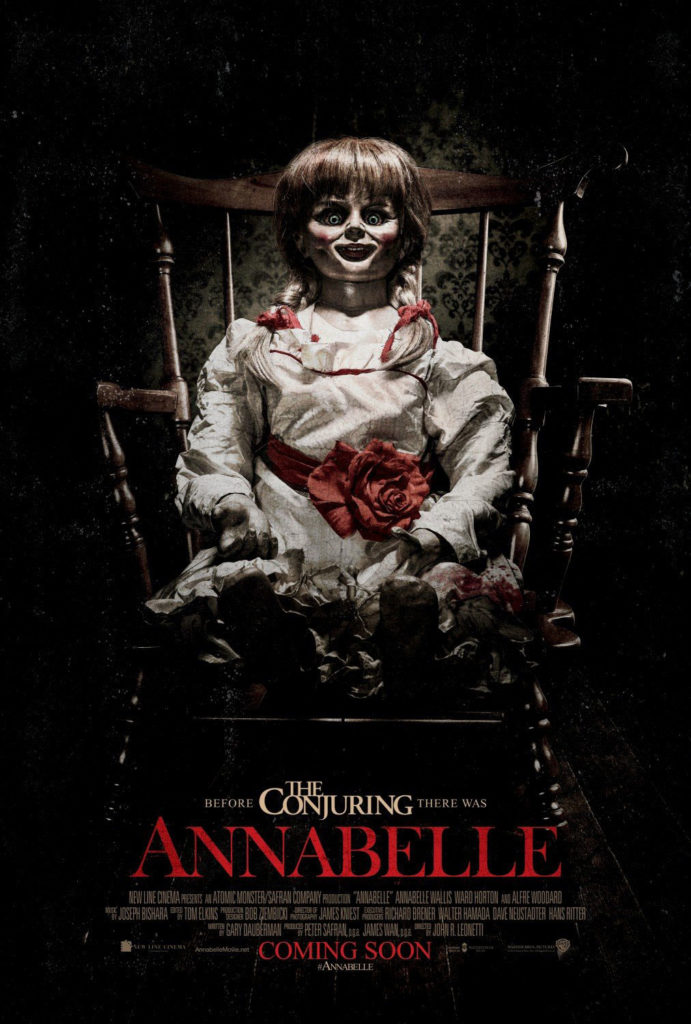The Conjuring was a horror movie that exceeded expectations. With a budget of around 20 million bucks, a combination of good script, good direction, good acting, and good scares pushed what could have been a boilerplate horror experience into something memorable that brought in over a quarter of a billion dollars at the box office. With such a return on investment, it was a certainty that there would a follow-up.
Annabelle, directed by John R. Leonetti and written by Gary Dauberman, tells the story of a demon-possessed doll, first seen in prologue at the start of The Conjuring. That makes this film somewhat of a prequel and somewhat of a spinoff. There’s not much point in delving into the distinctions too closely. It’s enough for audience members to know that there is a doll, it’s been seized by some supernatural entity, and it’s terrorizing a young family in 1969 Los Angeles.
But, there is some sloppy continuity that needs to be addressed. The film tells the origin of the supernatural afflictions in total, leaving little for the audience to infer on their own. Early on in the film, we see the soon to be bedeviled family, Mia and John Form (Annabelle Wallis and Ward Horton), and their as-yet unborn child, attacked by a murderous pair of SoCal occultists. The Forms survive the attack, injured, but whole. One of the assailants is shot dead by the police, while the other, Annabelle Higgins, commits suicide in the Form’s nursery  rather than be taken by the police. As she is dying, she scrawls an occult symbol on the wall in her own blood, and expires while holding a doll from a collection Mia installed in the nursery.
rather than be taken by the police. As she is dying, she scrawls an occult symbol on the wall in her own blood, and expires while holding a doll from a collection Mia installed in the nursery.
Soon after, weird and malicious stuff begins happening to Mia. Events, and the way the film plays out, point to the doll being haunted by the spirit of Annabelle Higgins. But, we soon learn that the cult to which Higgins and the other attacker belonged had been attempting to summon a demon, and it is that which has attached itself to the doll, not Annabelle Higgins. The continuity problems come because before the word ‘demon’ was ever uttered in the film, the story was set up completely for the doll to be haunted by Annabelle. It is her spectral form we see haunting Mia and her child, not the demon. Only after a very creepy basement scene does the film change course. It feels as if we viewers have been the victim of a clumsy bait and switch on the part of the filmmakers, almost as if they had little concern for viewers’ attention spans.
Luckily, the rest of the film is pretty good. Mia moves through her life as a housewife while her husband is away being a resident at a local hospital (the film comes close to beating 1960s gender roles to death, but, honestly, it’s not worth getting bothered over), therefore she receives the brunt of the demon’s attentions. The demon’s motives are opaque until some useful exposition comes along, and we learn that demons only want one thing when they appear on earth: a soul. And they will not stop until they get one. Mia and John begin to fear for the safety of their new child, and the remainder of the film is spent trying to figure out how to rid themselves of the demon. Tossing the doll in the garbage is not enough.
Wallis and Horton do fine as the film’s two leads, although by the last act Horton’s role had been reduced to a peripheral character. That meant that Wallis would have to handle the bulk of the screen time. She was capable, but got some help from Alfre Woodard, who plays a neighbor/local occult expert by the name of Evelyn. Her role, at first, seems to exist solely to provide some of that much-needed exposition. But her character also cleaves a little too closely to a clichéd voodoo priestess for comfort. This film walks a fine line when it comes to identity politics, I must say. Anyway!
Annabelle is a film with strong set pieces. The plot that weaves these pieces together can be hit and miss. But, it did what horror movies set out to do at their most basic. It scares. It also looks good doing it.
Annabelle didn’t rake in as much cash as The Conjuring, but it also cost a whole lot less to make. I think Annabelle will be returning in another feature not long after this review is posted.
